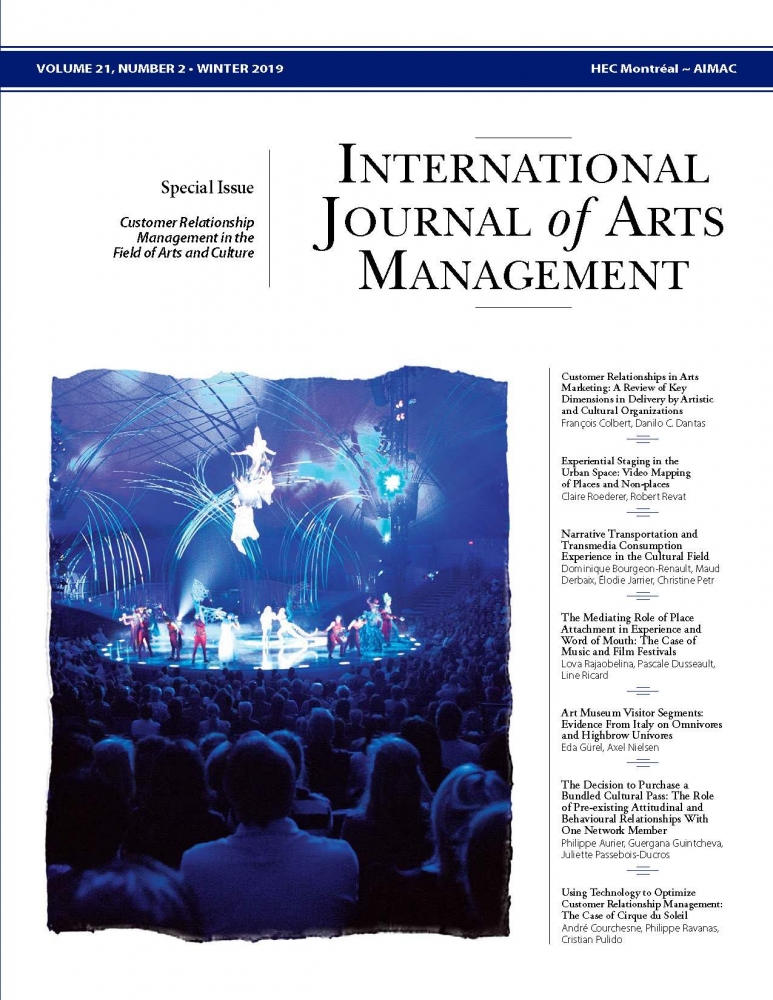IJAM Volume 21 Number 2 (PDF)
Product: Journal
$53.00 CA
FROM THE EDITOR AND THE GUEST EDITOR
Since the beginning of the new millennium, many researchers have been exploring the experiential nature of arts and culture. First, they focused on the ways in which arts organizations enrich and personalize the artistic experience. Then, they set out to analyze the consumption experience in the arts through the lenses of co-creation and co-production. Finally, with the development of data banks, researchers have been studying how to identify, track and improve consumption experiences through Customer Relationship Management (CRM).
The objective of this issue of the Journal is to report on the progress being made in each of these areas of research. In the first article, François Colbert and Danilo C. Dantas review the literature on the main dimensions (aesthetic, social, service-related) of the cultural experience, in terms of quality, and discuss the role of emotions, involvement, pleasure and the quality of the customer relationship in satisfaction, purchase intention and consumer loyalty.
The next two contributions look at how cultural organizations have been striving to enrich the consumption experience. Claire Roederer and Robert Revat analyze two video, sound and light installations in urban spaces to highlight the hedonic characteristics of public spaces and non-spaces. Then, Dominique Bourgeon- Renault, Maud Derbaix, Élodie Jarrier and Christine Petr describe how artistic organizations use transmedia platforms to immerse audiences in a fictional universe through narrative transportation; they illustrate how narrative transportation acts as a trigger for involvement and contributes to the co-creation of the experience.
Lova Rajaobelina, Pascale Dusseault and Line Ricard examine the important role played by festivals in the realm of cultural consumption and how place attachment acts as a mediator between the consumer experience and word of mouth. Eda Gürel and Axel Nielsen analyze the experience of visitors to two museums in Italy, while reviewing the research on univore and omnivore cultural consumers; their results show that these two segments have different expectations of the museumgoing experience. Philippe Aurier, Guergana Guintcheva and Juliette Passebois-Ducros also focus their research on museum visitors, in this case in order to identify which factors have the most impact in the purchase of a special pass providing access to a group of museums; these authors show that satisfaction is the most important factor when the pass is bought in high-end museums, while trust and commitment play a larger role in low-end museums.
Finally, in the Company Profile for this issue of IJAM, André Courchesne, Philippe Ravanas and Cristian Pulido demonstrate how Cirque du Soleil has been able to improve its CRM, enhance customer loyalty and personalize its offerings by integrating all of its audience interactions in a single database; this has allowed the company to refine its main customer profiles, enrich its data bank with information gleaned from social networks, and monitor, in real time, spectators’ satisfaction level for each of its productions in multiple geographic markets.
| André Courchesne Editor |
Danilo C. Dantas Guest Editor |
